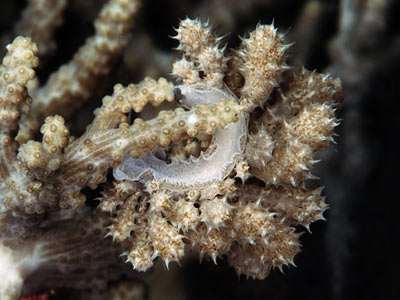
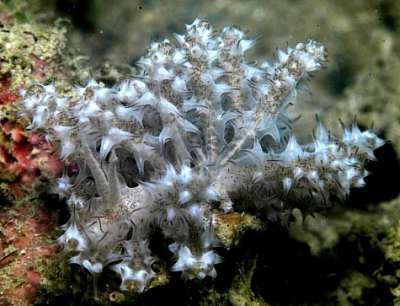
Phyllodesmium koehleri
Burghardt, Schroedl & Wagele, 2008
Order: NUDIBRANCHIA
Superfamily: AEOLIDINA
Family: Glaucidae
DISTRIBUTION
Known from southern Queensland, Australia (Cobb, 2004); Okinawa, Japan (Bolland, 2005); Sulawesi, Indonesia (Sozzani, 2004) and New Britain, Papua New Guinea (Barrett & Barrett, 2004), Philippines (Koehler, 2008).
PHOTO
Upper: Manado, North Sulawesi, Indonesia. Depth: 12 m., Length 2-3 cm. Photo: Roberto Sozzani. Lower: Lindenhaven Bay, New Britain, Papua New Guinea. 7 meters depth. January, 2004. Photo: John & Debra Barrett.
The body, including oral tentacles, rhinophores, foot and cerata, is transparent to translucent clear, with some white dusting. Thin brown streaks and patches, caused by zooxanthellae in small branches of the digestive gland, are scattered all over. Animals elongate, up to approximately 56 mm in length. The rhinophores and slightly shorter oral tentacles are smooth and tapering. The anal papilla is prominent and situated dorso-laterally just behind the second ceratal cluster on the right side. The cerata are arranged in groups and it seems the first cluster on each side is an arch, while the rest are in sloping rows on each side. The cerata are club-shaped, relatively thin at the base but expanding to a much greater diameter near the tip. Each ceras has many large pointed tubercles radiating out laterally. Each tubercle has a brownish duct of the digestive gland running out to the tip. Zooxanthellae are present in the cells and lumen of the digestive gland ducts. The jaw plates and radular teeth are similar in shape to those of P. jakobsenae [see #14684]
Phyllodesmium koehleri differs from all other described Phyllodesmium species in its choice of food. From available information on the Forum it seems to specialize on members of the Nephtheidae, probably Paralemnalia or Lemnalia [Sozzani, 2004 see #12313 - identification by P. Alderslade]. The unique spiny cerata of P. koehleri mimic parts of these soft corals and distinguish it from other species. Unlike xeniid feeding species, the cerata are never curled in the upper part, and like other non-xeniid feeders it has branches of the digestive gland within the body wall.
- Burghardt, I., Schroedl, M. & Wagele, H. 2008. Three new solar-powered species of the genus Phyllodesmium Ehrenberg, 1831 (Mollusca: Nudibranchia: Aeolidioidea) from the tropical Indo-pacific, with analysis of their photosynthetic activity and notes on biology. Journal of Molluscan Studies, 74: 277-292.
Rudman, W.B., 2008 (August 29) Phyllodesmium koehleri Burghardt, Schroedl & Wagele, 2008. [In] Sea Slug Forum. Australian Museum, Sydney. Available from http://www.seaslugforum.net/find/phylkoeh
Related messages
Phyllodesmium koehleri on possible food
September 8, 2008
From: Erwin Koehler
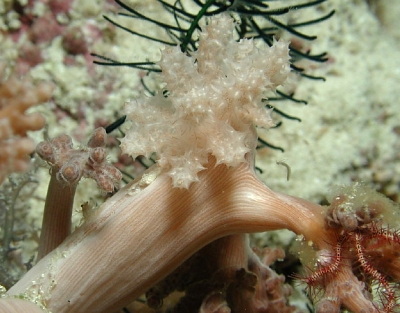
Concerning message #12313:
Dear Bill
scanning through your recent Messages I remembered a shot of Phyllodesmium koehleri on its possible food.
Locality: Cabilao Island, divesite Lighthouse, nightdive, 9m, Philippines, Pacific Ocean, 27 February 2003. Length: 25 mm. Photographer: Erwin Koehler.
Cheers
Erwin
Erwin@Philippine-Sea-Slugs.com
Koehler, E., 2008 (Sep 8) Phyllodesmium koehleri on possible food. [Message in] Sea Slug Forum. Australian Museum, Sydney. Available from http://www.seaslugforum.net/find/21867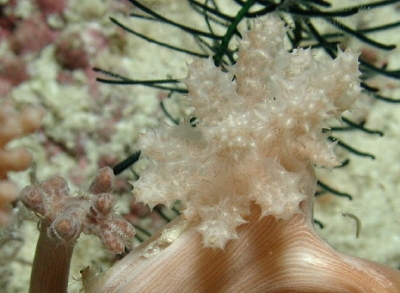
Thanks Erwin,
Phil Alderslade identified the soft coral this species feeds on as probably Paralemnalia or Lemnalia [see Fact Sheet] and your soft coral in your photo certainly seems to belong to that group of neptheid soft corals, which still need a lot of work.
- Fabricius, K. & Alderslade, P. 2001. Soft Corals and Sea Fans. Australian Institute of Marine Science: Townsville. 264pp.
Best wishes,
Bill Rudman
Phyllodesmium koehleri from southern Queensland
September 1, 2008
From: Gary Cobb
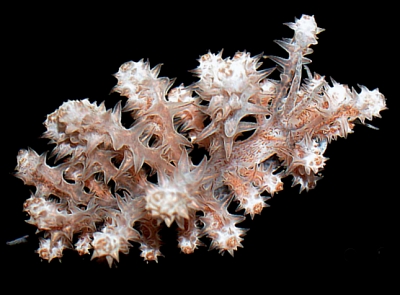
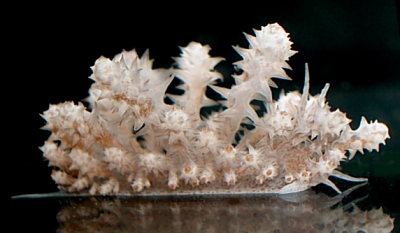
Concerning message #12313:
Hi Bill and everyone!
I wish to add to the Forum a newly described species previously known as Phyllodesmium sp. 2. We found this animal a little while ago and thought you might like to add it to the growing list of wonderful critters!
Locality: Old Woman Island, Mooloolaba, Sunshine Coast, 12m, Queensland, Australia, Pacific Ocean, 05 December 2004, Subtidal. Length: 31mm. Photographer: Gary Cobb.
Cheers
Gary
gary@nudibranch.com.au
Cobb, G.C., 2008 (Sep 1) Phyllodesmium koehleri from southern Queensland. [Message in] Sea Slug Forum. Australian Museum, Sydney. Available from http://www.seaslugforum.net/find/21841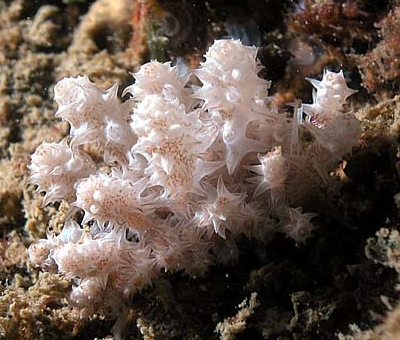
Dear Gary,
Thanks for these photos. Yes this species has just been named Phyllodesmium koehleri.
Best wishes,
Bill Rudman
Phyllodesmium koehleri from Sabah, Borneo
September 1, 2008
From: Richard Swann
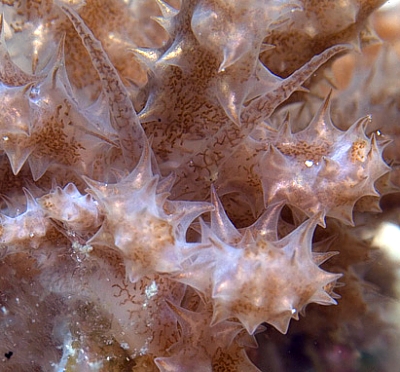
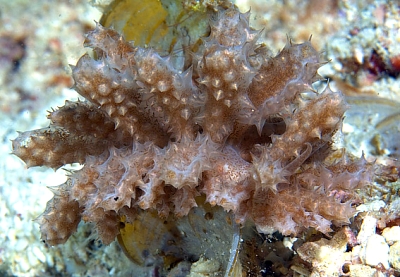
Concerning message #12313:
Hi Bill
I believe this to be Phyllodesmium sp 2 ?
Sorry I have no feeding or mating shots but i thought you may at least like another distribution record. I have included a close up of the rhinophores as they are so well hidden.
Locality: Kapalai island, 14 m, Sabah, Borneo, Celebes Sea, 11 March 2008, Sheltered reef. Length: 60-70 mm. Photographer: Richard Swann.
I hope you find it of interest.
Kind regards
Richard
www.downbelow.co.uk
richard@downbelow.co.uk
Swann, R., 2008 (Sep 1) Phyllodesmium koehleri from Sabah, Borneo. [Message in] Sea Slug Forum. Australian Museum, Sydney. Available from http://www.seaslugforum.net/find/21465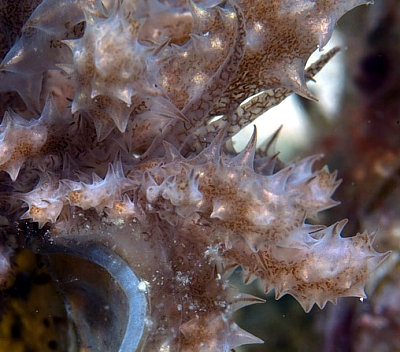
Dear Richard,
As you will see from the other messages posted today, this species has recently been named Phyllodesmium koehleri. Thanks very much for these close-ups which show the brown branches of the digestive gland so well - even into the rhinophores and body wall. As in all these solar-powered species, the brown colouration is from the symbiotic zooxanthellae which grow in their bodies.
Best wishes,
Bill Rudman
Phyllodesmium koehleri from the Philippines
September 1, 2008
From: Erwin Köhler
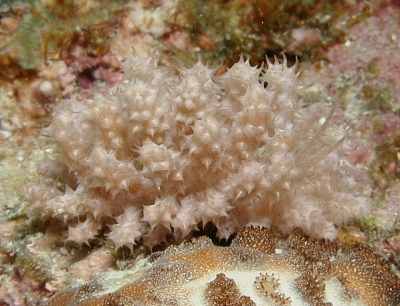
Dear Bill,
Here are 2 shots from the Philippines, Cabilao island, divesite "busstop" of Phyllodesmium sp. 2. Ingo Burghardt wants to know, if somebody is working on decribing it, else he would like to do it (I collected these specimens for his research)
Locality: Philippines, Cabilao island, divesite "busstop". Lengths: 44 mm, 47 mm. Depth 5 m. 04 May 2003.
Cheers
Erwin
Erwin@Philippine-Sea-Slugs.com
Koehler, E., 2008 (Sep 1) Phyllodesmium koehleri from the Philippines. [Message in] Sea Slug Forum. Australian Museum, Sydney. Available from http://www.seaslugforum.net/find/10172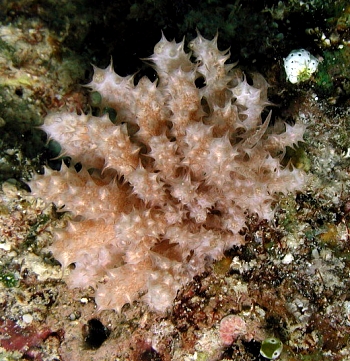
Dear Erwin,
You sent this message some years ago to the Forum and for some unfortunate reason it was never posted. All I can say is that sometimes I get overwhelmed with messages.
As I am sure you will know, Ingo Burghardt and his colleagues have just named this species Phyllodesmium koehleri in well deserved recognition of your help and interest in nudibranchs [see message #21853 ].
-
Burghardt, I., Schroedl, M. & Wagele, H. 2008. Three new solar-powered species of the genus Phyllodesmium Ehrenberg, 1831 (Mollusca: Nudibranchia: Aeolidioidea) from the tropical Indo-pacific, with analysis of their photosynthetic activity and notes on biology. Journal of Molluscan Studies, 74: 277-292.
Best wishes
Bill Rudman
Three new species of Phyllodesmium.
September 1, 2008
From: Bill Rudman
A paper has just been published (Burghardt, Schroedl & Wagele, 2008) describing another three new solar-powered species of Phyllodesmium. Phyllodesmium lizardensis from Lizard Island, on the Great Barrier Reef (Australia) and P. lembehensis from Sulawesi (Indonesia) are two more species feeding on octocorals of the family Xeniidae and both are closely associated with their food and are well camouflaged, their cerata mimicking the tentacles of the xeniid polyps. In vivo measurements of photosynthetic activities in P. lizardensis and P. lembehensis indicate a symbiotic relationship with zooxanthellae at least for some days.
The third species, Phyllodesmium koehleri, has been previously reported on the Forum as Phyllodesmium sp. 2. It has spectacular cactus-like cerata, and the extensive branching of the digestive gland ducts in the body wall and even the rhinophores suggest a well-developed symbiotic relationship with zooxanthellae. It is suggested it most probably feeds on neptheid soft corals of the genera Lemnalia or Paralemnalia.
As many of you will know, this is one of my favourite groups of aeolid nudibranchs, so any new information on them and their fascinating symbioses with soft corals and zooxanthellae is always welcome.
- Burghardt, I., Schroedl, M. & Wagele, H. 2008. Three new solar-powered species of the genus Phyllodesmium Ehrenberg, 1831 (Mollusca: Nudibranchia: Aeolidioidea) from the tropical Indo-pacific, with analysis of their photosynthetic activity and notes on biology. Journal of Molluscan Studies, 74: 277-292.
Bill Rudman
Rudman, W.B., 2008 (Sep 1) Three new species of Phyllodesmium.. [Message in] Sea Slug Forum. Australian Museum, Sydney. Available from http://www.seaslugforum.net/find/21853Phyllodesmium sp. 2 from Indonesia
February 27, 2004
From: Roberto Sozzani
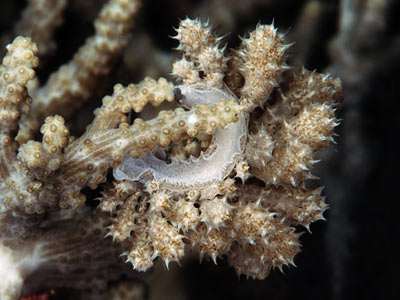
Note added 1 September 2008: This species, previously know as Phyllodesmium sp. 2 on the Forum, has recently been named Phyllodesmium koehleri. [see message #21853].
Dear Bill,
Today, reading one of the last posts [#12307] I think I've identified an animal I found in June 2003 while diving in Indonesia. Can you please confirm this is Phyllodesmium sp.2?
Location: Manado - North Sulawesi
Depth: 12 m.
Size: 2-3 cm.
Water temp.: 28°C.
I spent some time looking in soft corals. I had many surprises, like this one. Its mimetism was perfect, only in the photos you can see it rather well and its "spiny" cerata, the only visible difference with it's coral host.
Many thanks, as usual...
Best regards
Roberto Sozzani
roberto.sozzani@fastwebnet.it
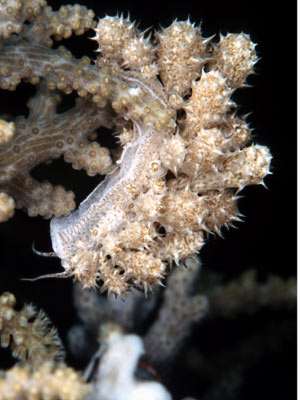
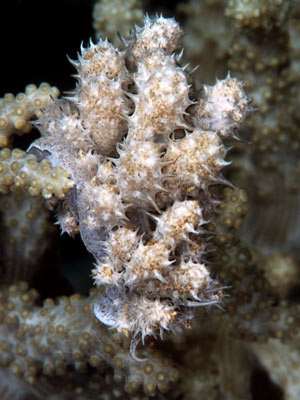
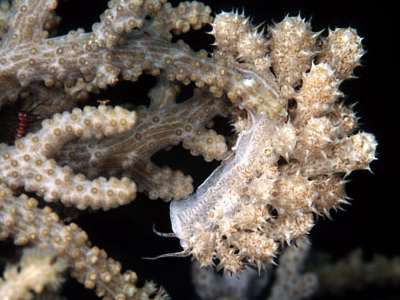
Dear Robert,
Yes it is Phyllodesmium sp.2. Hopefully we will be able to identify the soft coral it is living on from your photos. I suspect this is a 'solar powered' species, the brown specks on its bosy and ceratal skin being clusters of single-celled plants [zooxanthellae] it gtes from the soft corals. Some species of this genus show remarkable degrees of camouflage, when living on their soft coral hosts.
Best wishes
Bill Rudman
Phyllodesmium sp 2 from New Britain
February 25, 2004
From: John & Debra Barrett
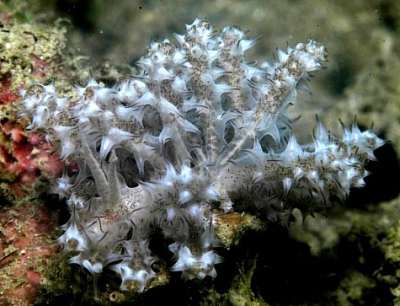
Note added 1 September 2008: This species, previously know as Phyllodesmium sp. 2 on the Forum, has recently been named Phyllodesmium koehleri. [see message #21853].
Dr. Rudman
Attached is a picture of a nudibranch my wife and I observed off the south coast of New Britain, Papua New Guinea in Lindenhaven Bay. The animal was observed at approximately 7 meters depth just off shore a mangrove coast. No one on the boat had seen this species and we can't find it in the books available to us and hope you can help.
We saw it during the last week of January, 2004.
John & Debra Barrett
john@barrettag.com
Barrett, J. & D., 2004 (Feb 25) Phyllodesmium sp 2 from New Britain. [Message in] Sea Slug Forum. Australian Museum, Sydney. Available from http://www.seaslugforum.net/find/12307Dear John,
This is one of the many strange, cryptic, species of the aeolid genus Phyllodesmium which are found in the Indo-West Pacific. This one is on the Forum as Phyllodesmium sp. 2.
Best wishes
Bill Rudman
Phyllodesmium sp. on food
May 30, 2000
From: Atsushi Ono
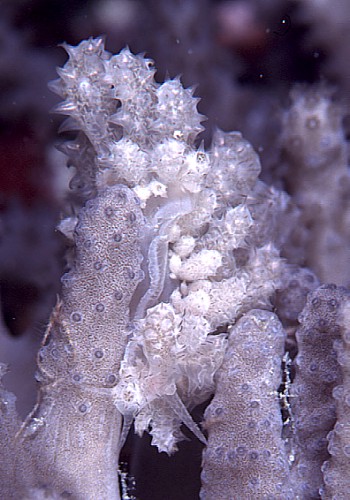
Note added 1 September 2008: This species, previously know as Phyllodesmium sp. 2 on the Forum, has recently been named Phyllodesmium koehleri. [see message #21853].
Dear Bill
I think the attached is photo is Bob Bolland's Phyllodesmium sp. 1.
I found it crawling on a species of soft corals. I found two individuals at 31m, Kerama Is. near Okinawa.
This species is very similar to soft corals opening polyps so it is very difficult to find it.
Sincerely,
Atsushi Ono
ononini@cosmos.ne.jp
Ono, A., 2000 (May 30) Phyllodesmium sp. on food. [Message in] Sea Slug Forum. Australian Museum, Sydney. Available from http://www.seaslugforum.net/find/2475Dear Atsushi,
Thanks very much. This is indeed another beautiful example of camouflage, for which many species of Phyllodesmium are famous.
Best wishes,
Bill Rudman.
Phyllodesmium spp from Okinawa
August 4, 1998
From: Bob Bolland
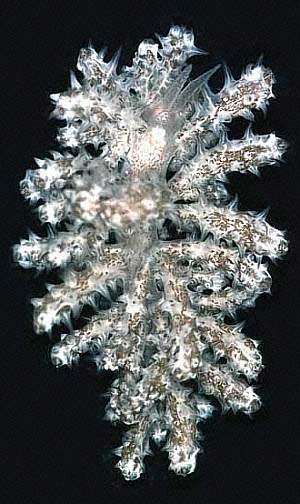
Note added 1 September 2008: This species, previously know as Phyllodesmium sp. 2 on the Forum, has recently been named Phyllodesmium koehleri. [see message #21853].
Dear Bill:
I have seven identified species of Phyllodesmium from here on Okinawa to date (Phyllodesmium briareum, crypticum, hyalinum, kabiranum, macphersonae, magnum, and poindimiei) and at least another twelve or so that I simply don't know. I'm enclosing a scan of what I believe to be yet another animal for the Okinawa species list, P. iriomotense (Baba, 1991), originally described from Iriomote Island, here within the Ryukyus Archipelago. I've collected three specimens from moderately deep water (two from 58m and one from 67m) while on SCUBA. All three of the animals were found apparently feeding on two separate species of octocorals, from which they were collected. The individual in the accompanying photo had a total living length of 44mm and was collected from 67m on 18 July, 1995.
I didn't wish to overload your resources with too many images so in addition to P. iriomotense, I'm only enclosing a single unknown for the time being. Phyllodesmium unk #1 was collected from 40m and had a total living length of 56mm; It was found crawling on top of strewn coral rubble and collected on 18 April, 1989. It's the only individual I've found here.
Photo: Unnamed species of Phyllodesmium (Bolland unknown sp #1), Okinawa, at 40m. It was found crawling on top of strewn coral rubble and collected on 18 April, 1989. PHOTO: Bob Bolland.
The sea slug forum continues to be a great service for getting opisthobranch information out over the Internet. Please keep up the terrific work.
Best regards,
bob
Bob Bolland
Okinawa
bolland@imicom.or.jp
Bolland, R.F., 1998 (Aug 4) Phyllodesmium spp from Okinawa. [Message in] Sea Slug Forum. Australian Museum, Sydney. Available from http://www.seaslugforum.net/find/187Dear Bob,
Thanks for the photos. Don't worry about overloading the system. I am happy to post anything you send. Concerning your unknown Phyllodesmium. I have it from New Caledonia and it is indeed unnamed and is one of a number I am planning to describe when they add a couple of extra days to each week.
To those unfamiliar with the genus, all species of Phyllodesmium feed on octocorals (alcyonarians, soft corals) and they have unique characters which seem to be associated with that lifestyle. Their radular teeth are quite distinctive and the cnidosac at the tip of each ceras, where defensive nematocysts are stored in most aeolids, has been replaced by a large gland which produces white sticky secretions. Also probably as a defensive strategy, species of Phyllodesmium can break off cerata when they are disturbed. The cerata covered in sticky secretions, wiggle and writhe around for some time after being cast off, which I presume is to distract predators from persevering with the rest of the animal.
Another interesting feature of at least some species of Phyllodesmium is their ability to remove zooxanthellae (single-celled plants) from their soft coral food and store them alive in their own bodies. The evidence suggests that some species of Phyllodesmium can utilise the sugars produced by these stolen plants for their own nutrition. Have a look at Solar powered nudibranchs for some more information on this.
Bill Rudman
Rudman, W.B., 1998 (Aug 4). Comment on Phyllodesmium spp from Okinawa by Bob Bolland. [Message in] Sea Slug Forum. Australian Museum, Sydney. Available from http://www.seaslugforum.net/find/187